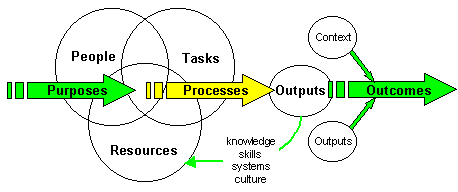![]()
Other topics
Why think in terms of
Systems?
Human beings create systems to solve three
problems in terms of their success and
well-being
- To understand our experiences
- To help ensure that important things are achieved
- To make it easier to achieve these important things

This is all possible because a systems view greatly increases our capacity to
- Analyse (study and check)
- Design (plan: what is to be achieved and how)
- Develop (make the design practical)
- Implement (make our initiatives part of our endeavours)
- and Continuously Improve what we are doing
Systems
Thinking
Systems exist as mental constructs in
people's minds. Thinking in terms of systems
helps us make sense of complex situations over
time. We attempt to build 'working models' of
what we are dealing with. This means we are
trying to understand and describe the
connections between
- people
- purposes
- resources (time, knowledge, effort, $, facilities...)
- processes
- tasks
- actions
- outputs
- outcomes
Continuous
Improvement
Thinking is terms of
systems is essential so that we can implement
continuous improvement, viz, so that we can
- plan (design, arrange, schedule, train, ...)
- do
- study and
- act to improve (redesign, rearrange, reschedule, retrain, ...)
Dealing with
Complexity
As human activities
have become more complex and the environments in
which humans operate have become relatively less
supportive so it has been necessary to create
new and improved systems to solve the problems
that arise.
Many economic, social and natural phenomena can be better understood in terms of systems.
Education is clearly delivered, at least in part by 'school systems'. And there are systems operating with schools, classrooms, and even within the people participating in the educational processes.
Everyone
works in a system
And systems determine 85-95% of what
is achieved: good, bad or indifferent!! It is
common for this proposition to be rejected
by staff on the basis of "What about us
!?!".
It can be useful to consider that while we
create systems to help us achieve they also
largely determine what we subsequently
achieve. We create systems and then we have to
work within them.
If systems determine 85-95% of what we achieve
what are the implications for staff
appraisal !?!
Systems have parts
- contributors (suppliers)
- contributions (inputs)
- processes: central & supporting
- products and/or services (outputs)
- recipients (customers)
Each part of a system is an opportunity for improvement
Warning !!! Quality
optimises the system as a whole not
individual parts of the system. Optimising
each part of the system simultaneously fails to
optimise the system. Consider an orchestra:
every instrument playing loudly through the
entire performance would not be a quality
(delightful) experience.
Effective systems
are purposeful. They have
- A mission: a known purpose
- A vision of how things should be
- A set of values as a basis for responding, eg, approval, rejection,...
In managing systems quality
uses improvement first (and changes
things when there is no other alternative).
Change is competitive, costly & disruptive.
System
change
There are three key questions
- What to change?
- What to change to?
- How to cause the change? (Goldratt)
Systems
may be unstable
Systems and the processes within may,
or may not, be under control. Systems are
not manageable (cannot be improved) until
they are brought under control. Unstable systems
may have
- Faulty processes
- Untrained or misinformed people
- Too many disruptions from outside
Stabilise the system before trying to improve it,
- Get class or school routines working before attempting to improve the curriculum
- Eliminate special causes of variation: encourage the pet owner to improve their fences and make arrangements with the local council for prompt collection of any visiting dogs if necessary
The process of bringing a system under control is to
- Make the system explicit so that there is wide spread, shared understanding of it
- Reduce the incidence and impact of special causes of variation
- Work on the system to reduce the common causes of variation, and
- Remove unnecessary activities
- Improve the effectiveness of the system
- Implement continuous improvement (plan-do-study-act).
Everyone and everything (teachers, other staff, parents, bus drivers, students, the Department, community, profession...and facilities, equipment, materials, policies, culture, practices,...) are all part of "the School" as a system.
Implications:
- It is wise to value (and utilise) the knowledge that people have about their part in the scheme of things.
- We should be cautious about making value judgements about the people with whom we work.
- We work in very complex situations in which very few individuals have sufficient control to genuinely be responsible for the system.
Action: Change from control, isolation & assessment to team building. Effective teams work in the same system and share responsibility for to management and development
![]()